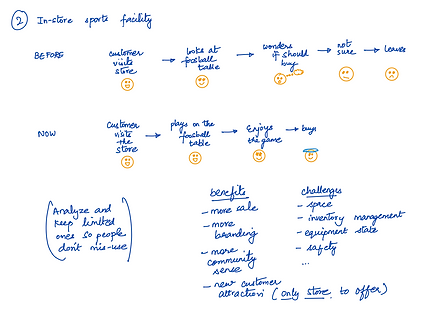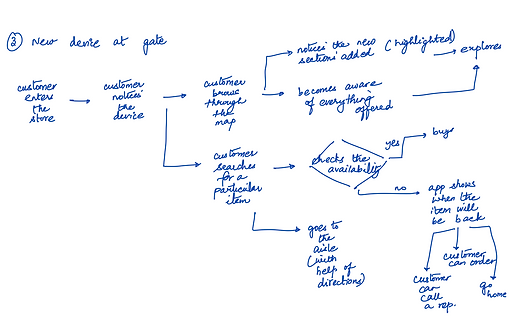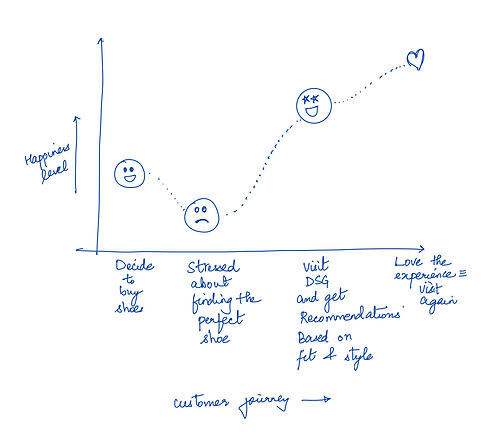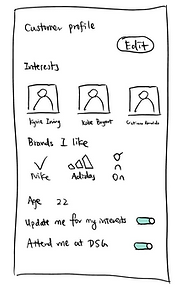

TRUESHOE
In-store personalized shoe recommendations tailored to customer's unique feet, style, and purchase history.
Client: Dick's Sporting Goods
MY ROLE:
Research: semi-structured interviews, guerilla research, experiential research, stakeholder analysis, analogous domain analysis, personas, usability testing
Design: concept maps, user scenarios, storyboards, journey mapping, service blueprint, low-fi prototypes, service design
TIMELINE:
7 Weeks
Fall 2022
TOOLS:
Figma
Service Blueprint
TEAM:
2 Undergrad HCI Students
3 Master's PM Students
CONTEXT
What is the project goal?
What is the solution?
Enhance the shoe-shopping experience in the DSG store
The current shoe-shopping experience lacks personalized touch and convenience, leading to multiple trials to find a perfect fit, high return rates, and dissatisfied customers.
An in-store shoe-buying experience that utilizes advanced foot analysis technology and AI algorithms.
Employee device integration for effortless recommendations
Partnerships with startups for precise foot profile measurement devices
Unique customer profiles accessible through the DSG app
GPS technology integration to personalize experience
AI-powered notifications
Figure: Key Service Features offered
To facilitate service introduction, we presented a visually captivating poster and an engaging promotional video that highlighted the seamless benefits of our offering.

Figure: Service Poster

Figure: Service Promotional Video
RESEARCH
Extensive Background Research to understand the domain
Our approach had to surpass the typical product-focused approach. We analyzed DSG's annual reports, organizational structure, employee dynamics, brand image, and store environments and explored their competitors.

Figure: Screenshot of DSG's annual report indicating total assets

Figure: Me and my teammate buying an item to experience end-to-end DSG service
Thorough background research allowed us to ask unique, unsearchable questions during our first client meeting, leading us to uncover unique and valuable insights.

Figure: Raw background research split by different categories
We opted for guerrilla research with customers and employees, as we couldn't offer compensation for their participation. To enhance collaboration, I developed a concise list of activities and discussion points for observing and engaging with users.



Figure: Research Guide created to facilitate Guerilla research and experiential research
SYNTHESIS
Performing Affinity Diagramming to discover insights

Figure: We clustered our findings from all sources - secondary, experiential and primary research
Our research revealed intriguing challenges in finding the perfect-fitting shoes at DSG stores. Collaborating and noting even minute observations, such as the crowd congregating around the shoe aisle, were pivotal in gaining valuable insights.
Customers buy 8 shoe on average per year
21% of DSG’s Sale attributed to footwear in 2021 (as per the annual report)
More than half the customers visit shoe section at DSG
Customers have to try 3+ pairs on average tried before making a decision
3/5 shoppers wear the wrong shoe size
Figure: Key data found on shoe-shopping experience

Size and fit

Cushioning

Style Preferences

Gait
Figure: Some of the factors people consider before buying a shoe
Icons credit: Olena Panasovska
To offer a comprehensive understanding of DSG's operations and highlight insights from our research, I crafted a service blueprint—an essential artifact for our team.

Figure: Service blueprint and customer journey map as a research artifact
IDEATION
Rapid Idea Generation

Figure: Reverse Assumption Ideation technique
After understanding the current state, we used different ideation techniques like Reverse Assumptions and Creative Matrix to generate innovative ideas collaboratively.

Figure: Creative Matrix ideation technique
I applied my ability to create visual concept maps and encouraged my team to do the same, which proved powerful for swiftly conveying and aligning ideas within a limited timeframe.





Figure: Five concept maps created by me, showcasing potential project directions.

Figure: Consolidated Themes from Diverse Ideas
After consolidating ideas, we dot-voted and unanimously agreed on personalized shoe services as the direction for innovation within the shoe aisle.


Figure: Updated service blueprint: Meticulously outlining touchpoints for our chosen idea, ensuring a comprehensive customer journey
Right: Digital Form, Left: Raw Whiteboard Collaboration
I created various visual artifacts to enhance the client's understanding. These visuals were invaluable during the presentation, bridging the gap between design and business for a client with strong business acumen but no design background.

Figure: Value Flow Concept Map depicting how value flows between different components impacted by the new service introduction

Figure: Concept Map: Before and After state in customer shopping experience

Figure: Storyboard illustrating customer pain point and the new service's solution

Figure: Emotional Journey Concept Map - Customer's Experience During Shoe Shopping
Acknowledging the impact of our solution on DSG employees, we prioritized their needs as an important archetype/persona, ensuring our solution catered to their requirements too.
PROTOTYPING AND TESTING
Setting up a service setup for genuine user feedback
We developed low-fidelity prototypes and a virtual DSG store, incorporating a DSG poster, a shoe aisle on a monitor, and a makeshift measuring device. These tools provided valuable feedback and helped refine our concept.





Figure: Low-fi version of the user flow
Participants valued personalized greetings and customized recommendations. However, comparing users to actors or sports personalities for an enhanced experience proved inaccurate. Hence, we modified our service based on this feedback.
After the usability session, we finalized our service proposition and its implementation at the store. We then created a poster and promotional video to present this change to our client.

Figure: Room setup for testing
IMPACT
Client's reaction
The client recognized the idea's potential to convert visitors into loyal customers and achieve significant revenue growth with proper implementation. He even suggested gradual expansion of the service to other sections beyond the shoe section.
REFLECTION
Lessons Learned

Figure: Team Photo
This project, part of the "service design" course at CMU, provided deep insights into designing captivating and seamless service experiences. It emphasized that each touchpoint presents a unique opportunity to encourage customer retention.
Working with the interdisciplinary team enriched my personal and professional growth significantly. Guiding the team, I adeptly conveyed design concepts to non-design individuals, fostering a shared vision and ensuring active engagement and support throughout the design process.